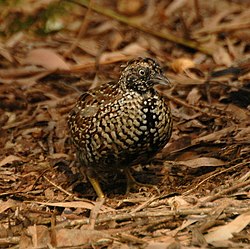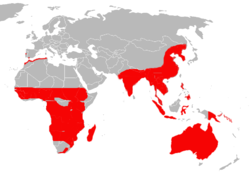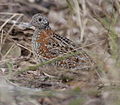| Buttonquail | |
|---|---|
 | |
| Black-breasted buttonquail (Turnix melanogaster) | |
| Scientific classification | |
| Kingdom: | Animalia |
| Phylum: | Chordata |
| Class: | Aves |
| Order: | Charadriiformes |
| Family: | Turnicidae Gray, GR, 1840 |
| Type species | |
| Tetrao gibraltaricus [1] Gmelin, 1788 | |
| Genera | |
| |
 | |
| Distribution of the buttonquails | |
Buttonquail or hemipodes are members of a small family of birds, Turnicidae, which resemble, but are not closely related to, the quails of Phasianidae. They inhabit warm grasslands in Asia, Africa, Europe, and Australia. There are 18 species in two genera, with most species placed in the genus Turnix and a single species in the genus Ortyxelos .
Contents
Buttonquails are small running birds that avoid flying. Unusually among bird species, the female is the more richly colored of the sexes. While the quail-plover is thought to be monogamous, Turnix buttonquails are sequentially polyandrous; both sexes cooperate in building a nest in the earth, but normally only the male incubates the eggs and tends the young, while the female may go on to mate with other males.






